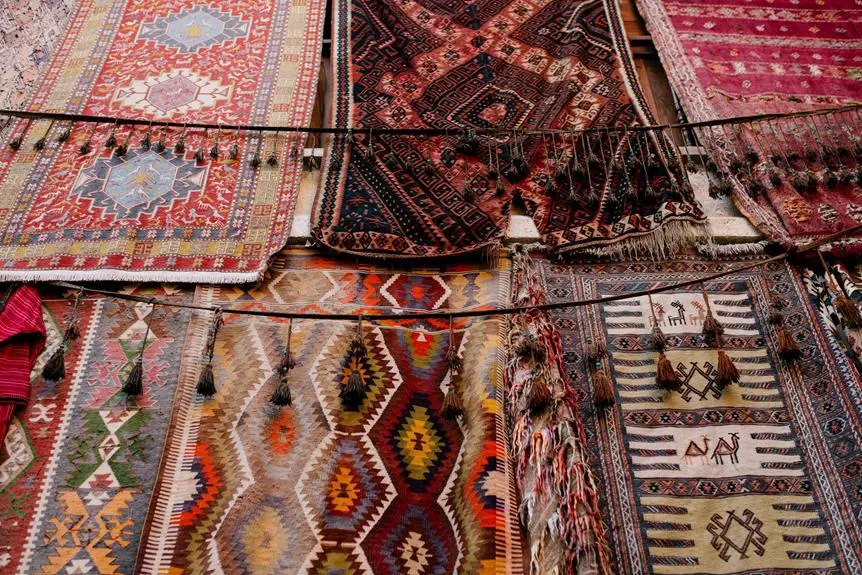You might not realize how much acrylic fabric has shaped modern textiles since its invention in the 1940s. Born from innovative polymer chemistry and commercialized as 'Orlon,' this synthetic alternative to wool quickly transformed fashion and home decor. As you explore its journey from initial popularity to its current focus on sustainability, you'll uncover the surprising ways acrylic continues to influence the industry. What might surprise you even more is how these advancements are redefining its future and our relationship with textiles.
Table of Contents
Key Takeaways
- Acrylic fabric was developed in the 1940s as a synthetic alternative to wool, spurred by wartime fabric demand.
- Dr. Otto Röhm introduced polyacrylonitrile in 1930, laying the foundation for acrylic fiber production.
- The 1950s saw acrylic gain popularity in fashion, home decor, and automotive textiles for its durability and affordability.
- Innovations like moisture-wicking technology and digital printing have enhanced acrylic's performance and aesthetic appeal.
Inception of Acrylic Fabric
Acrylic fabric was first developed in the 1940s as a synthetic alternative to wool, offering a lightweight and durable option for various textiles. You might be surprised to learn that this revolutionary material emerged during World War II, when there was a pressing need for versatile and effective fabrics. Scientists aimed to create something that could mimic the natural properties of wool without its drawbacks.
By combining polymerization techniques and innovative chemical processes, researchers succeeded in producing acrylic fibers that were soft, resilient, and resistant to moths and mildew. This made the fabric particularly appealing for a range of applications, from clothing to home furnishings.
You'll find that acrylic quickly gained popularity in the fashion industry, as it provided a cost-effective solution for manufacturers looking to create stylish yet practical garments. Additionally, acrylic's vibrant colors and ease of dyeing opened up new possibilities for designers.
As you explore the fabric's journey, you'll see how its unique properties paved the way for future developments in textile technology. The inception of acrylic fabric marked a significant turning point, influencing both consumer choices and industry standards in the decades to come.
Early Innovations and Developments
Let's explore the origins of acrylic fiber and how it transformed the textile industry.
You'll discover key innovations that marked significant milestones in its development and industrial adoption.
Understanding these early advancements will give you a clearer picture of acrylic fabric's evolution.
Origins of Acrylic Fiber
In the early 20th century, scientists began experimenting with synthetic fibers, leading to the groundbreaking development of acrylic fiber. You might find it fascinating that the journey started with chemists like Dr. William H. Carothers, who sought to create a viable alternative to wool. His research focused on polymer chemistry, which laid the foundation for acrylic's creation.
By the 1940s, major advancements were made. Researchers successfully developed polyacrylonitrile (PAN), the primary component of acrylic fibers. This innovation caught the attention of textile manufacturers, who recognized its potential for versatility and durability. You can appreciate how acrylic's lightweight and water-resistant properties opened up new possibilities in various applications, from clothing to upholstery.
Acrylic fiber began to gain popularity during the post-war era, as consumers sought affordable and stylish alternatives to traditional fabrics. Its soft texture and vibrant colors made it particularly appealing.
As you explore the origins of acrylic fiber, you'll see how it revolutionized the textile industry, paving the way for a multitude of creative uses that continue to thrive today.
Key Innovations Timeline
The timeline of key innovations in acrylic fiber showcases a series of breakthroughs that transformed the textile landscape. Understanding these early developments helps you appreciate the versatility and applications of acrylic fabric today.
- 1930: Invention of Acrylic Fiber – Dr. Otto Röhm introduces polyacrylonitrile, marking the birth of acrylic fiber.
- 1940s: Commercial Production – The first commercial production of acrylic fibers begins, leading to widespread use in textiles.
- 1950: Branding as “Orlon” – The introduction of the Orlon brand establishes acrylic fibers as a staple in the fashion industry.
- 1960s: Innovations in Blending – Manufacturers begin blending acrylic with other fibers, enhancing durability and comfort, which further broadens its appeal.
These innovations laid the groundwork for acrylic fabric's rise in popularity.
From home textiles to high-fashion apparel, the adaptability of acrylic fibers has been one of the key factors in their enduring success.
As you explore the history of acrylic fabric, recognizing these milestones will deepen your understanding of its impact on modern textiles.
Industrial Adoption Milestones
During the 1950s, industries began to recognize acrylic's potential, leading to its rapid adoption in various sectors, including fashion, home furnishings, and automotive textiles. You'll find that acrylic's lightweight and durable properties made it an attractive alternative to traditional fabrics. This versatility allowed designers to explore new possibilities, creating vibrant and innovative pieces that appealed to consumers.
In the fashion industry, acrylic revolutionized knitwear. It became a staple for sweaters and scarves, offering warmth without the weight of wool.
Home furnishings also saw a shift, as manufacturers incorporated acrylic into upholstery and carpets, providing a wide range of colors and patterns that made homes more stylish and functional.
The automotive industry embraced acrylic for its resistance to fading and wear, making it ideal for seat covers and interior trim. This trend not only enhanced vehicle aesthetics but also improved longevity.
As you look back, it's clear that these early innovations laid the groundwork for acrylic's enduring presence across various sectors, proving its adaptability and appeal in the ever-evolving marketplace.
Rise to Popularity
Acrylic fabric quickly gained traction in the textile industry due to its innovative properties and versatility.
You'll find it used in everything from fashion to home decor, making it a go-to choice for many designers and consumers alike.
Its rise to popularity reshaped how we think about and use synthetic materials in everyday life.
Innovation in Textile Industry
How did acrylic fabrics become a staple in the textile industry, capturing the attention of designers and consumers alike?
Well, it all boils down to a combination of innovation and versatility that acrylic offers. Unlike traditional fabrics, acrylic is lightweight, durable, and resistant to fading, making it a go-to choice for various applications. You'll find that its unique qualities have sparked a surge in creativity within the textile realm.
Consider these key factors that contributed to acrylic's rise:
- Color Retention: Acrylic fabrics maintain their vibrant hues even after multiple washes, appealing to consumers who desire longevity in their purchases.
- Softness and Comfort: The soft texture of acrylic mimics wool, making it a favorite for cozy garments without the itchiness.
- Cost-Effectiveness: Compared to natural fibers, acrylic is often more affordable, allowing designers to work within budgets while maintaining quality.
- Easy Care: Acrylic is machine washable and quick-drying, appealing to the modern consumer's need for convenience.
These innovations have solidified acrylic's position as a beloved fabric in today's textile industry.
Versatile Applications and Uses
The versatility of acrylic fabrics has led to their widespread use in everything from fashion to home décor, making them a favored choice among designers and consumers. You'll find acrylic in various applications, owing to its lightweight, durable, and water-resistant qualities. This adaptability has seen it rise in popularity across different industries.
Here's a quick overview of some of the key applications of acrylic fabrics:
| Application | Benefits | Common Uses |
|---|---|---|
| Outdoor Gear | Weather resistance, durability | Tents, awnings, and tarps |
| Upholstery | Stain resistance, vibrant colors | Furniture coverings |
| Sportswear | Breathability, moisture-wicking | Activewear and swimwear |
In these areas, acrylic fabrics excel due to their ability to maintain shape, color, and comfort. You'll appreciate how easily it can mimic natural fibers, making it a practical choice for various products. As you explore the many uses of acrylic, you'll see why it's become a staple in modern design and manufacturing.
Fashion and Home Decor
Why has acrylic fabric surged in popularity within fashion and home decor?
You're witnessing a blend of practicality and style that makes acrylic an ideal choice for modern consumers. Its lightweight nature and vibrant colors allow you to express your personality, whether in your wardrobe or living space. Plus, its resistance to fading and wear makes it a long-lasting option.
Here are four reasons why acrylic's popularity is on the rise:
- Versatility: Acrylic fabric adapts easily to various styles, from chic dresses to cozy throw blankets, fitting seamlessly into any aesthetic.
- Affordability: Compared to natural fibers, acrylic is often more budget-friendly, making it accessible for everyone looking to revamp their style or home.
- Easy Care: You'll love how acrylic is machine washable and quick to dry, requiring minimal effort for maintenance.
- Sustainable Options: With advances in recycling technology, you can now find eco-friendly acrylic fabrics, appealing to the environmentally conscious consumer.
With these benefits, it's no wonder acrylic fabric continues to thrive in fashion and home decor.
Technological Advancements
Numerous technological advancements have transformed acrylic fabric production, enhancing its durability and versatility for various applications. These innovations have enabled manufacturers to create fabrics that resist fading, wear, and moisture, making them ideal for both indoor and outdoor use. You'll notice how modern acrylic fibers boast improved softness and breathability, elevating comfort and usability.
One of the key advancements is the development of advanced spinning techniques, which optimize the fiber density and strength. Additionally, the incorporation of nanotechnology has led to fabrics with enhanced stain resistance and UV protection. By utilizing digital printing methods, manufacturers can also achieve vibrant colors and intricate designs without compromising the fabric's integrity.
Here's a quick overview of some technological advancements in acrylic fabric production:
| Advancement | Description |
|---|---|
| Advanced Spinning Techniques | Improves fiber density and strength |
| Nanotechnology | Enhances stain resistance and UV protection |
| Digital Printing | Allows for vibrant colors and intricate designs |
| Moisture Wicking Technology | Improves breathability and comfort |
| Eco-Friendly Processes | Reduces environmental impact during production |
These advancements not only improve the fabric's performance but also align with consumer demands for sustainability and quality.
Applications in Fashion
With its enhanced durability and vibrant aesthetics, acrylic fabric has carved a significant niche in the fashion industry, offering designers a versatile material for innovative clothing and accessories.
Its lightweight nature and ability to mimic the look and feel of natural fibers make it a popular choice for various applications. You'll find acrylic fabric used in a variety of fashion items that cater to different styles and occasions.
Here are some key applications of acrylic fabric in fashion:
- Sweaters and Knitwear: Acrylic's warmth and softness make it ideal for cozy sweaters, cardigans, and other knit garments.
- Activewear: Its moisture-wicking properties ensure comfort during workouts, making it a preferred choice for leggings, sports bras, and tops.
- Costumes and Theatrical Wear: The vibrant colors and designs available in acrylic fabric lend themselves well to creative costumes and stage outfits.
- Accessories: From scarves to hats, acrylic fabric is lightweight and easy to care for, making it perfect for a range of stylish accessories.
Incorporating acrylic into your wardrobe opens up countless creative possibilities, blending functionality with style.
Impact on Home Textiles
Acrylic fabric has transformed home textiles by offering durability and vibrant colors that enhance any living space. You'll find that its lightweight nature and resistance to fading make it a popular choice for upholstery, curtains, and rugs. Unlike natural fibers, acrylic resists moisture and mildew, making it ideal for areas prone to humidity, like kitchens and bathrooms.
When you choose acrylic for your home, you're not just opting for style but also practicality. Its easy-care properties mean you can toss it in the wash without worrying about shrinking or losing its shape. This fabric's ability to mimic the look and feel of wool without the associated maintenance makes it an attractive alternative for modern homeowners.
Acrylic's versatility allows you to experiment with various textures and patterns, giving your space a fresh, contemporary feel. Whether you prefer bold prints or subtle designs, there's an acrylic option that fits your aesthetic.
As you redecorate or refresh your home, consider how acrylic fabric can add both beauty and functionality to your textiles, ensuring your living space remains inviting and stylish for years to come.
Future of Acrylic Fabric
As you explore the future of textiles, acrylic fabric stands out for its potential to embrace sustainability while maintaining its appealing qualities. Innovations in production methods and the growing focus on eco-friendly materials are shaping the trajectory of acrylic fabric. You'll see a shift towards using recycled acrylic fibers, which not only reduces waste but also conserves resources.
Here are four trends to watch:
- Recycled Materials: Manufacturers are increasingly using post-consumer plastics to create new acrylic fibers, minimizing environmental impact.
- Biodegradable Options: Research is underway to develop biodegradable acrylics that can break down more easily in landfills.
- Enhanced Performance: Future fabrics will likely include improved moisture-wicking and UV-resistant properties, making acrylic more versatile for various applications.
- Eco-Conscious Brands: More brands are prioritizing sustainable practices, encouraging consumers to choose eco-friendly acrylic products.
Frequently Asked Questions
What Are the Environmental Impacts of Acrylic Fabric Production?
Acrylic fabric production can lead to significant environmental issues. It involves petroleum-based materials, consumes energy, and generates waste. You should consider these impacts when choosing fabrics for sustainable fashion and eco-friendly living.
How Does Acrylic Fabric Compare to Natural Fibers?
When you compare acrylic fabric to natural fibers, you'll find acrylic offers durability and moisture resistance, while natural fibers provide breathability and comfort. Each has its advantages, depending on your specific needs and preferences.
Can Acrylic Fabric Be Recycled Effectively?
Yes, acrylic fabric can be recycled effectively, though the process isn't as widespread as with natural fibers. You can find recycling programs that accept acrylic, helping reduce waste and promote sustainability in textiles.
What Are Common Care Instructions for Acrylic Garments?
When caring for acrylic garments, wash them in cold water using a gentle cycle. Avoid bleach and fabric softeners. You can tumble dry on low or lay flat to dry to maintain shape.
Are There Any Health Concerns Related to Acrylic Fabric?
Yes, acrylic fabric can cause skin irritation or allergic reactions in some people. If you notice any discomfort while wearing it, it's best to stop using it and consult a healthcare professional for advice.
- How Does Ring Spun Cotton Affect Garment Fit and Shape Retention? - August 13, 2024
- What Are the Challenges in Producing Ring Spun Cotton? - August 13, 2024
- Is Ring Spun Cotton Suitable for Plus-Size Clothing? - August 13, 2024





